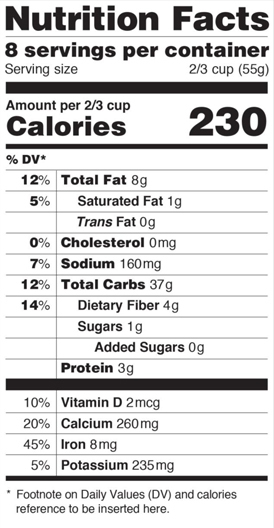From The Hill:
The Food and Drug Administration isn’t ready to embrace mandatory labeling regulations for foods made with genetically engineered ingredients, despite an aggressive push from lawmakers and advocates who cite health concerns.
Testifying before a House panel, FDA Commissioner Margaret Hamburg told lawmakers this week that the agency remains comfortable with a 1992 policy decision concluding that food made with genetically modified organisms — or GMOs — is not materially different from other products.
“We have not seen evidence of safety risks associated with genetically modified foods,” Hamburg said during a House Appropriations Committee hearing to assess the FDA’s 2015 budget request.
She said the FDA is working on fresh guidance backing a voluntary system for GMO labeling, an approach critics regard as insufficient.
Rep. Nita Lowey (D-N.Y.) criticized the FDA’s unwillingness to impose mandatory labeling requirements, saying the action is the least the government can do to give consumers more information about the food on their dinner table.
“It’s beyond me that we can’t have accurate labeling,” Lowey told Hamburg at the hearing. “The labeling can’t hurt anybody but it’s possible that the lack of adequate labeling could, of course.”
Actually, neither of those statements are true. The labels could hurt people and the lack of labeling won’t.
First let’s get some basics out of the way. What qualifies as a “genetically modified organism”? Have a purebred dog in your house? That’s one. A rose bush in your garden? Yep, that too. In essence, any living being that has been bred for certain traits is a genetically modified organism. What the critics are upset with are industrial processes by which companies can cultivate these traits in the lab instead of breeding for them over the course of generations.
So, is there a reason to be concerned? Over to the Competitive Enterprise Institute’s Gregory Conko, writing in the Washington Examiner earlier this week:
The primary thing that makes genetic engineering unique is the power and precision it gives us to make those changes and then test for safety afterward. It has also given us food that is both safer for our families and better for the environment. Plants with a built-in resistance to chewing insects, for example, have allowed farmers to use millions of gallons less pesticide every year.
Dozens of the world’s most prestigious scientific bodies, including the National Academies of Science, the American Medical Association and the World Health Organization, have studied genetic engineering for more than 30 years and concluded that such foods are at least as safe as, and often safer than, conventionally bred ones.
The other thing that makes genetically modified plants different is they are subject to intense scrutiny by three different regulatory agencies in the U.S. alone. It takes an average of five to 10 years to develop and test a crop for consumer and environmental safety. This is followed by an additional two to four years of review by the Food and Drug Administration, Department of Agriculture and Environmental Protection Agency. And because most American farmers will not plant genetically modified crops they cannot export to global markets in Europe, Asia and South America, the wait is even longer in order to secure approval overseas.
The regulatory costs alone for testing and getting approval for a genetically modified plant variety average more than $35 million. By the time a new crop makes it to market, its safety has been confirmed by regulators in dozens of countries.
In 30 years of testing and commercial use in more than two dozen countries, genetically modified foods have caused not a single sniffle, sneeze or bellyache. This outstanding safety record is why the FDA does not require blanket labeling of such foods. It does, however, require labeling any time a food differs from its conventional counterpart in a meaningful way – such as a reduction in nutrients, the introduction of an allergen, or even a change in taste or smell.
The science here is overwhelming — and has a decades-long track record. That’s part of what makes the labeling idea such a bad one. Proponents often brush the evidence aside and claim that, even if the produce is safe, consumers should know what’s in their food (though, in many cases, what’s in it is no different with GMOs than organics). But that’s not cost-free. There’s the price, of course, of actually producing the labeling, but the bigger potential cost is the loss of business that would occur if GMO labeling became pervasive.
The point of labeling as a tool of regulation is to increase consumer knowledge. In this area, however, it’s likely that labeling would only fuel ignorance. The public is already poorly informed about GMOs. Mandating they be labeled — which gives the appearance of a warning — would only fuel fears that have no basis in science.
Those who care the most about GMOs are those who are already eating organic foods — foods, it should be noted, that go out of their way to market themselves as an alternative to GMOs. In other words, the market has already solved their problem. There’s no compelling reason — as a matter of science or policy — for them to be allowed to brand the GMOs that feed hundreds of millions of Americans with a scarlet letter just because of their scientific illiteracy.



 In an interview with CFIF, Sally Pipes, President and Chief Executive Officer of the Pacific Research Institute, discusses how the federal government fumble on the meningitis vaccine Bexsero is partially to blame for outbreaks of bacterial meningitis on college campuses and how other regulatory hurdles in the healthcare arena must be taken down.
In an interview with CFIF, Sally Pipes, President and Chief Executive Officer of the Pacific Research Institute, discusses how the federal government fumble on the meningitis vaccine Bexsero is partially to blame for outbreaks of bacterial meningitis on college campuses and how other regulatory hurdles in the healthcare arena must be taken down. CFIF Freedom Line Blog RSS Feed
CFIF Freedom Line Blog RSS Feed CFIF on Twitter
CFIF on Twitter CFIF on YouTube
CFIF on YouTube